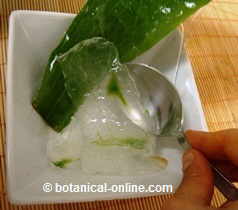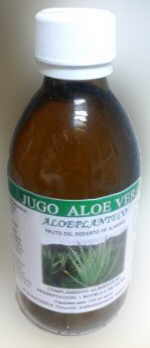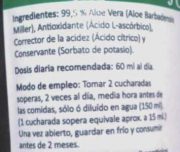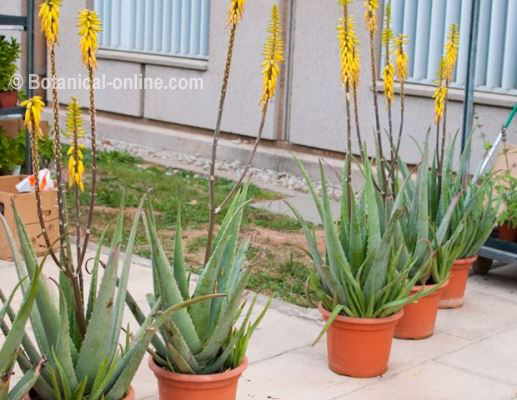Contents
Benefits of aloe juice
Aloe vera or Barbados aloe, medicinal plant
Aloe or aloe vera (Aloe vera) is a succulent plant of African origin that can

currently be found in most warm areas of the world. Its use is mainly due to its skin-vulnerary properties, which are well known in practically the entire world.
It is one of the best plants for the skin: the juice found inside the leaves of aloe is rich in mucilage, substances with demulcent, softening, soothing and healing properties for the skin.
In addition to these properties, aloe juice can also have beneficial effects when ingested, mainly due to the properties exerted by mucilage:
Properties of aloe vera juice for internal use
- Digestive system: Mucilage is a type of soluble fiber that provides a gelatinous texture to aloe. This gel covers the mucosa of the stomach and intestines, protecting it from digestive juices and helping to repair it and heal wounds. For this reason, aloe gel is a great ally of the digestive system. Among the different digestive disorders in which aloe gel can help us, we highlight:
- Gastritis: The mucilage has demulcent, soothing and protective properties of the gastric mucosa, reducing pain and acidity. It is recommended in case of gastritis, heartburn, ulcer or stomach problems as a powerful regenerator of the gastric mucosa (1-2 tablespoons of aloe juice, 30 minutes before meals with 1 glass of water). (Products containing at least 98% of aloe, without aloin or aloe emodin (stomach irritating components) are recommended).
- Constipation: Mucilages are fermentable fibers that help prevent

Aloe juice is suitable when there is constipation or relieve constipation by increasing the volume of feces and facilitating defecation.
- Intestinal diseases: Mucilages are fermentable fibers by the bacteria of the colon, favoring the proliferation of beneficial bacteria of the intestine (prebiotic effect). Together with a proper diet, aloe helps to regenerate the intestinal flora. It is recommended after treatment with antibiotic drugs, or in situations where the intestinal flora or microbiota may be weakened (high stress, celiac disease, etc.).
It is also suitable in case of intestinal diseases, Crohn’s disease, colitis, leaky gut syndrome, diverticulitis, etc., in which, in addition to its digestive and soothing properties, it can act as an anti-inflammatory.
- Cough and sore throat: Aloe mucilage is very useful internally for the treatment of cough, bronchitis, asthma, aphonia or throat irritation. Its protective, softening and soothing action on the mucous membranes acts to soothe an irritated throat and reduce inflammation. (Take 1 -2 tablespoons of aloe juice with expectorant infusion for cough, for example, eucalyptus, mint or boldo)
- Cholesterol: A diet rich in soluble fiber, such as that provided by aloe juice, helps reduce high cholesterol levels, prevents obesity and associated diseases such as type 2 diabetes and certain types of cancer.
Without an associated diet and healthy lifestyle habits, aloe juice alone is not a remedy against cholesterol. In a third of patients taking between 10 ml or 20 ml daily for about three months, 70% did not show any benefit against cholesterol.
Aloe vera for diabetes?
It is being studied whether aloe vera is capable of lowering blood sugar in people with type II diabetes. Although some studies have been positive, there is not enough evidence to affirm that this plant should be used in the treatment of diabetes
Recipe: Preparation of homemade aloe juice
Homemade aloe juice is obtained from fresh aloe leaves. First, the leaves are cut, then they must be washed, peeled, passed through water to remove the yellowish layer, and the resulting gel soaked in water for about 2 hoursv in the refrigerator (add water approximately to cover).
During soaking, the aloe gel releases its mucilage (medicinal component) into the water, because it is a soluble substance. In this way we get the preparation to spread more, without having to cut too much of our plant. To make the juice, the entire previous mixture is crushed, which will result in a whitish and very gelatinous liquid. It should be stored in the refrigerator and consumed within in about 4 days.
The leaves can be collected every 6 months. Only about 2 or three leaves per plant should be removed. Aloe vera gel must be obtained properly so that the aloe acibar or aloe latex gel is separated from the gel. Instructions in images:
How to obtain homemade aloe gel. Prepared by ©Botanical-online.com. Drawing by: ©Dibujosparapintar.com
Buy aloe juice

For people who do not have this plant, it is possible to find aloe juice in most supermarkets, pharmacies, herbalists, specialized stores and online stores. Its medicinal principles, mucilage, do not deteriorate during the juice production process, since it is resistant to heat.
There are many products with aloe vera. When looking for aloe juice for internal use, it is very important that the label states that it is an edible product.
Creams with aloe vera intended for internal use should not be ingested because in many cases they may contain toxic cosmetic additives.
It is recommended to consult the label and buy those products that contain only or mainly aloe gel (it should be the first ingredient on the list) and that are intended for internal use (that indicate a food supplement on the label or that specify that it can be drunk).
One of the advantages of prepared juices from the herbalist is that, as they contain preservatives, they can be stored longer in the refrigerator than homemade preparations, which are more susceptible to bacterial spoilage.
Aloe for internal use is also available in powder form, which has been obtained by freeze-drying previously cut aloe leaves. Freeze-drying makes preparations that are mainly presented in the form of extracts, dry powder, capsules or tablets.
What amount should be taken?

We are not interested in the nutritional properties of aloe juice, because it is not a notable source of macronutrients, vitamins or minerals.
To obtain its medicinal properties for the skin and mucous membranes, it is enough to take the amount of fiber found in doses of 1-2 tablespoons, 2 to 3 times a day.
It can be added to fruit juices, yogurt, milk, even teas or any preparation.
Drinking a glass of aloe juice has no benefits other than its use in the recommended doses. In fact, it is better to take aloe juice throughout the day, because in this way you can protect the digestive mucosa all day.
However, a glass of aloe provides a large contribution of mucilaginous fiber, which may be appropriate in case of constipation. In these cases, half a glass (100-150 ml) would be sufficient and it should be accompanied by an appropriate diet for constipation.
Aloe vera acibar against constipation
Immediately after the skin of the aloe leaves is the aloe acibar, which is a yellowish latex with a bitter taste. Acibar is used internally for the treatment of constipation, because it contains anthraquinones, compounds with laxative effects.
However, it is not recommended to take it directly from the plant, since, if the doses are not respected, it can be very irritating to the digestive tract. Furthermore, the stimulant laxative effect is very powerful and has contraindications. Other less toxic laxative plants are generally used, such as senna or cascara sagrada infusions.
*Continue reading: Aloe vera toxicity
![]() More information on aloe vera
More information on aloe vera










